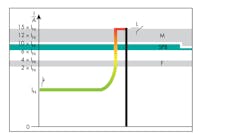Power Supplies and Circuit Breakers Keep Faults in Check
Download this article in PDF format.
In the last decade or so, significant advances have been made in the design of industrial power supplies and dc-dc converters, from the materials and device levels to size and weight reduction, thermal management, and package design. However, one often-overlooked category is protection of circuits and systems provided by the power supply and accompanying circuit breakers. These advances have contributed greatly to reliability and system availability while maintaining safety as well.
One of the most far-reaching is selective fuse breaking (SFB) or selective shutdown, which when enabled in both power supply and thermomagnetic, as well as other types of circuit breakers, provides significant benefits. There are two types of trip mechanisms in these thermomagnetic breakers—temperature-sensitive and magnetic—the former having a response delay and the latter almost instantaneous.
The temperature-sensing element of the circuit breaker consists of a bimetal strip with a heating coil. When current exceeds a threshold, the protective device generates heat in the coil, which causes it to bend and actuate the switch, shutting off power. The temperature-sensitive circuit is even effective when current is temporarily greater than nominal, such as when overload currents are shut down.
The magnetic trip mechanism consists of a solenoid coil and a plunger or pivoted armature. When current exceeds a specific threshold, a magnetic field is created in the coil, which attracts the armature to it and interrupts the circuit. Response time of this type is much faster than its counterpart, typically 3 to 5 ms, allowing it to respond to short-circuits and excessive overload currents.
Sponsored Resources:
1. Shown are the three common response curves available in thermomagnetic circuit breakers and the maximum current required to actuate them.
Thermomagnetic circuit breakers are available with one of three different characteristic response curves, M, SFB, and F and subsets of each, that suit specific operational situations. These curves are shown in Figure 1. The SFB characteristic provides the most overcurrent protection and prevents the breaker from switching off too soon, even when a very short overcurrent condition occurs, such as when the system is started. It also prevents long-lasting overload currents that would result in high equipment temperatures.
SFB-Curve Thermomagnetic Circuit Breakers
Phoenix Contact was the first to introduce thermomagnetic circuit breakers that follow the SFB curve, and are designed for use with power supplies that also are based on SFB technology. When combined, the two provide exceptionally reliable tripping, even with long cable lengths between the power supply and the devices it serves. For example, Figure 2 shows a short-circuit occurring on one of three devices connected in parallel over 25-m lengths of copper cable to a Phoenix Contact QUINT Series 20-A power supply, a control subsystem, and circuit breakers protecting each current path. In this case, a short-circuit occurred in the second-to-last device, so the power supply selectively cuts power to it while allowing the controller and the other devices to remain in operation.
2. This example shows a power supply, controller, and secondary devices, one of which experienced a short-circuit. SFB allows power to be removed from only the faulted circuit, enabling the controller and the remaining devices to continue in operation. Without this capability, the entire system would be shut down.
The power supply also delivers the large amount of power reserve required in systems like this one that have long power cable runs, in which the amount of current available for tripping the breaker is limited. In these cases, the current level is often too low to quickly trip the circuit breaker and may not trip it at all. In the interim between the event and when the breaker disconnects power, the voltage continues to flow, which can overload the controller and potentially damage or even destroy it.
By delivering a higher level of current than is normally required to trip the breaker (up to 10 times normal for 12 ms in Phoenix Contact QUINT SFB power supplies), such situations are prevented. The capability is useful for systems experiencing high start-up current peaks, too.
In addition to possibly causing equipment damage, a power supply/breaker combination without SFB would shut down the entire system, rather than electively addressing only the faulted circuit path. The power supply also provides comprehensive diagnostics that include output voltage and current monitoring of critical operating conditions, and alerts operators to critical operating states before errors occur.
Summary
Industrial power supplies are changing with requirements for higher efficiency and greater integration with the plant management systems where they’re located. They’re also increasingly incorporating features such as SFB circuit breakers that when combined with compatible power supplies are solving some basic problems, e.g., keeping equipment functioning in the event of a fault.
Without SFB, faults become a detriment to system availability, as they take an entire block of functions offline, even though only a single circuit has failed. The Phoenix Contact QUINT power supplies also complement SFB with comprehensive monitoring of key performance parameters that alert operators to potential problems before they result in a failure.
Sponsored Resources:
- QUINT POWER supplies provide maximum system reliability
- Using QUINT DC/DC converters, errors can be prevented in applications
- Phoenix Contact offers easy decoupling diodes providing power supply redundancy
Related Resource:


